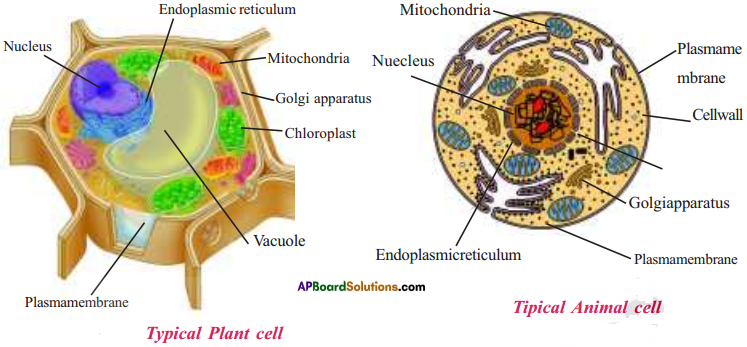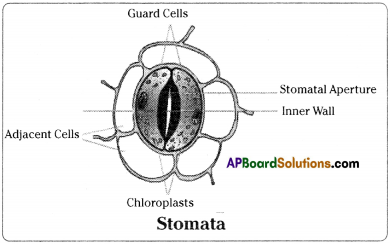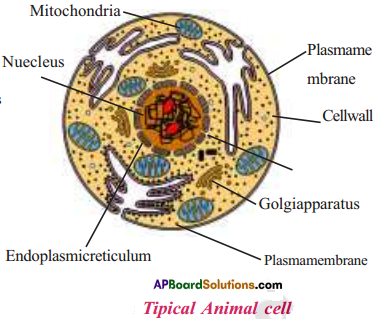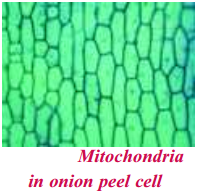 |
| AP Board Class 9 Biology Chapter 1 Cell its Structure and Functions Textbook Solutions PDF: Download Andhra Pradesh Board STD 9th Biology Chapter 1 Cell its Structure and Functions Book Answers |
Andhra Pradesh Board Class 9th Biology Chapter 1 Cell its Structure and Functions Textbooks Solutions PDF
Andhra Pradesh State Board STD 9th Biology Chapter 1 Cell its Structure and Functions Books Solutions with Answers are prepared and published by the Andhra Pradesh Board Publishers. It is an autonomous organization to advise and assist qualitative improvements in school education. If you are in search of AP Board Class 9th Biology Chapter 1 Cell its Structure and Functions Books Answers Solutions, then you are in the right place. Here is a complete hub of Andhra Pradesh State Board Class 9th Biology Chapter 1 Cell its Structure and Functions solutions that are available here for free PDF downloads to help students for their adequate preparation. You can find all the subjects of Andhra Pradesh Board STD 9th Biology Chapter 1 Cell its Structure and Functions Textbooks. These Andhra Pradesh State Board Class 9th Biology Chapter 1 Cell its Structure and Functions Textbooks Solutions English PDF will be helpful for effective education, and a maximum number of questions in exams are chosen from Andhra Pradesh Board.Andhra Pradesh State Board Class 9th Biology Chapter 1 Cell its Structure and Functions Books Solutions
| Board | AP Board |
| Materials | Textbook Solutions/Guide |
| Format | DOC/PDF |
| Class | 9th |
| Subject | Maths |
| Chapters | Biology Chapter 1 Cell its Structure and Functions |
| Provider | Hsslive |
How to download Andhra Pradesh Board Class 9th Biology Chapter 1 Cell its Structure and Functions Textbook Solutions Answers PDF Online?
- Visit our website - Hsslive
- Click on the Andhra Pradesh Board Class 9th Biology Chapter 1 Cell its Structure and Functions Answers.
- Look for your Andhra Pradesh Board STD 9th Biology Chapter 1 Cell its Structure and Functions Textbooks PDF.
- Now download or read the Andhra Pradesh Board Class 9th Biology Chapter 1 Cell its Structure and Functions Textbook Solutions for PDF Free.
AP Board Class 9th Biology Chapter 1 Cell its Structure and Functions Textbooks Solutions with Answer PDF Download
Find below the list of all AP Board Class 9th Biology Chapter 1 Cell its Structure and Functions Textbook Solutions for PDF’s for you to download and prepare for the upcoming exams:9th Class Biology 1st Lesson Cell its Structure and Functions Textbook Questions and Answers
Improve Your Learning
Question 1.
Differentiate between a) Plant cell and animal cell b) Prokaryotic and Eucaryotic cells. (AS 1)
Answer:
a)
| Plant Cell | Animal Cell |
| 1. Cell wall present. | 1. Cell wall absent. |
| 2. Chloroplasts present. | 2. Chloroplasts absent. |
| 3. Plant cell can perform photosynthesis. | 3. Animal cell cannot perform photosynthesis, |
| 4. Vacuoles are large in size. | 4. Vacuoles are small in size. |
| 5. Centrioles are absent. They appears only at the time of cell division. | 5. Centrioles present. |
b)
| Prokaryotic cell | Eucaryotic cell |
| 1. Nuclear membrane is absent. | 1. Nuclear membrane is present. |
| 2. The membrane bound cell organelles absent. | 2. Cell organelles are enclosed by membranes. |
| 3. Except ribosomes other organelles are absent. | 3. All cell organelles are present. |
| 4. They has a tough cell wall. | 4. Flexible, porus cell wall present in plants, plasma membrane present in animals. |
| 5. E.g. : Cynobacteria, blue green algae. | 5. E.g. : All higher plants and animals. |
Question 2.
What happens if plasma membrane ruptures or breaks? (AS 2)
Answer:
- Cell membrane or plasma membrane is covering of the animal cell.
- It separate cytoplasm from the external environment.
- It defined the shape and size of the cell.
- It plays a crucial role in maintaining a balance of various substances inside the cell.
- It controls the exchange of substances between the cell and its external environment.
- If it ruptured or broke, then the above activities will stop, the cell will die.
Question 3.
Prepare a model of plant cell or animal cell with locally available materials. (AS 5)
Answer:
Question 4.
What would happen to the life of cell if there was no golgi complex? (AS 2)
Answer:
- The golgi apparatus packed various substances before they are transported to other parts of the cell.
- If there was no golgi complex in the cell the proteins and other substances are not altered and packed.
- Substances transport will not occur.
- Regeneration or repair of the membrane will not takes place.
Question 5.
What happen to the cell if nucleus is removed? Give two reasons to support your answer. (AS 1)
Answer:
- If nucleus is removed from a cell, there would be no control on the functions of a cell.
- Cells are not involved in the process of cell division.
- The cell will not live for more time.
- E.g.: Red blood cells, not having nucleus live less time than the other cells, which are having nucleus.
Question 6.
Lysosomes are known as suicidal bags of the cell. Why? (AS 1)
Answer:
- Lysosomes contained the destructive enzymes.
- Thus the enzymes normally do not come in contact with the rest of the cell.
- The materials that need to be destroyed are transported to the lysosomes.
- At times, the lysosomes burst and the enzymes are released to digest the cell.
- Hence, lysosomes are known as suicidal bags of the cell.
Question 7.
Why do plant cell possess large sized vacuole? (AS 1)
Answer:
- Vacuoles are fluid filled sac-like structures.
- In a newly formed plant cell, the vacuoles are small.
- As the cell becomes old, these vacuoles, fuse to form a single large vacuole.
- In mature plant cells, they might occupy almost the entire cell space.
Question 8.
Prepare a temporary mount of any leaf peel observe the stomata draw their picture. Write a short note on the same. (AS 5)
Answer:
- A fresh leaf of Rheo is taken.
- Making a slit in the pith material and keep the leaf inside the slit.
- To get the T.S a leaf, section cutting with a blade should be done.
- The thin section with brush and keep the section on the slide.
- Putting a drop of water, glycer¬ine on it.
- Staining the section with saffronin.
- Cover the section with a cover slip.
- By observing under the microscope of the leaf. We can see stomata in the lower epidermis.
- They are enclosed by two kidney shaped cells, called guard cells.
- In between two guard cells a pore formed stomata.
Question 9.
“Cell is the basic unit of life” – explain the statement. (AS1)
Answer:
- The fundamental organizational unit of life is the cell.
- All living organisms are composed of cells.
- In unicellular organisms, a single cell performs all the the functions.
- In multicellular organisms, a no. of cells together performs different functions.
- So, we can say that “Cell is the basic unit of life”.
Question 10.
How do you appreciate about the organisation of cell in the living body? (AS 6)
Answer:
- Cell is the basic unit in the structural organisation of all living organisms.
- Cell carry physiological functions like oxidise food materials to derive energy.
- Excrete the waste materials.
- Increase in number by dividing into two identical cells.
- Defend itself against the attack of foreign organisms.
- Try to adjust to the conditions in its surroundings.
- Function of an organism depends on the functions carried out by the cell.
Question 11.
If the organisation of cell is destroyed due to physical and chemical influence, what will happen? (AS 6)
Answer:
- If the organisation of cell is destroyed due to physical and chemical influence, the cell will die.
- Sometimes it also effects the functions of other cells nearby.
Question 12.
Read the chapter carefully collect the information about the functions of different cell organelles and make a table which contains serial number. Cell organelle, function. Don’t forget to write your specific findings below the table. (AS 4)
Answer:
| Cell organelle | Functions |
| 1. Nucleus | 1. Regulates and controls all the functions of the cell. 2. Barrier of genetic information. 3. Determines the characteristics of the organism. 4. Cell division. |
| 2. E.R | 1. Transport of substances. 2. RER are the sites of protein manufactures. 3. SER helps in the manufactures of lipids. |
| 3. Golgi Apparatus | 1. Packing of various substances in the cell. 2. Secretion of proteins from the cell. |
| 4. Lysosomes | 1. Digestion of food materials 2. At the time of disease condition it digest the cell also. |
| 5. Mitochondria | 1. Generates and stores the energy. |
| 6. Plastids | 1. Chloroplasts trap the energy of sunlight during photosynthesis. 2. Chromoplasts are responsible for the colouring of fruits and flowers. |
| 7. Vacuole | 1. Storing of carbohydrates, amino acids, proteins, pigments and waste materials. |
Question 13.
How could you appreciate the function of tiny cell in a large body of an organism? (AS 6)
Answer:
- Cell is the basic unit in the structural organisation of ail living organisms.
- It is the functional and structural unit of the organism.
- Functions essential for survival of the organism are carried out at the level of a cell only.
- Each cell acts as an individual unit.
- In each cell excretion, generation of energy, defending itself, adjust to the conditions, production of new cells etc. functions are carried out.
- So we must appreciate the function of a tiny cell in a large body of an organism.
Question 14.
Look at the following cartoon of a cell. Find out the functions of cell organelles. (AS 5)
Answer:
| Cell organelle | Function |
| Nucleus | Nucleus regulates and controls all the functions of a cell and determines the characteristics of the organism. |
| Endoplasmic reticulum | 1. It serve as channels for the transport of materials within the cell. |
| 2. It also functions as a cytoplasmic framework for various biochemical activities. | |
| Golgi Apparatus | It package various substances. Proteins are altered slightly by golgi apparatus. |
| Lysosomes | It participates in intracellular digestion. It destroys the cell contents. |
| Mitochondria | It produces energy through cellular respiration. |
| Plastids | These are responsible for the colour of the plant cell. |
| A. Chloroplasts | These trap solar energy and convert this to chemical energy during photosynthesis. |
| B. Chromoplasts | These are responsible for the coloured fruits, flowers. |
| C. Leucoplasts | These are colourless, stores carbohydrates, oils and proteins. |
Question 15.
Who and when was “The cell theory” proposed? When did they prepare it? What are its salient features? (AS 1)
Answer:
M.J. Schleiden and Theodar Schwann proposed “The cell theory”. They prepared it in 1838 – 39.
Statements of modern form of cell theory :
- All the living organisms are made up of cells and their products.
- All the cells are formed from pre-existing cells.
- All the cells are made up of similar chemicals and show similar metabolic activities.
- Functioning of an organism depends on the functions carried out and the interac-tion of different cells present in the organism.
Question 16.
When you observing the nucleus of cheek cell in laboratory, what precautions do you take?
Answer:
While observing the nucleus of cheek cell in laboratory the following precautions are to be taken.
Precautions:
- Do not scrap the cheek too hard as it may injure the buccal mucosa.
- Scrapped material should be spread uniformly on the slide.
- Excess stains should be drained off.
- There should be no air bubbles under the coverslip.
Question 17.
Draw the typical animal cell and lable its parts.
Answer:
9th Class Biology 1st Lesson Cell its Structure and Functions InText Questions and Answers
9th Class Biology Textbook Page No. 1& 2
Question 1.
Observe the following figures.
a) What common features do you see in both the cells?
Answer:
We can observe some common features in plant and animal cells. They both are having plasma membrane, mitochondria, golgi apparatus, endoplasmic reticulum, nucleus etc.
b) Which cell organelles are found exclusively in plant cell?
Answer:
Chloroplasts and big vacuoles are the cell organelles exclusively found in plant cell.
9th Class Biology Textbook Page No. 3
Question 2.
What is the role of the cell wall in plant cells?
Answer:
It exerts an inward wall pressure to resist the outward pressure exerted by the cell sap.
9th Class Biology 1st Lesson Cell its Structure and Functions Activities
Activity – 1
Question 1.
How do you observe cell membrane in a peel of Rheo leaf under microscope? Draw the diagram of it. Write your observations.
Answer:
Take Rheo leaf, tear the leaf in single stroke take a small piece of leaf peel with light coloured (transparent) portion. Put it on slide and put a drop of water on it. Cover it with cover slip and observe the light portion of leaf under the microscope.
Observations:
- Cells are arranged in rows.
- Cell membrane is clearly seen.
- Nucleus is present in the cell.
Lab Activity
Question 2.
To observe the nucleus in cheek cells.
Answer:
Aim :
To observe the nucleus in cheek cells.
Material:
A tooth pick or ice-cream spoon or spatula, glass slide, coverslip, watch glass, needle, blotting paper, 1% methylene blue, normal saline, glycerine, microscope etc.
Procedure:
- Wash your mouth and scrap a little of the internal living of your cheek inside your mouth with a clean tooth pick or spatula or ice-cream spoon.
- Place the scrap in a watch glass containing a very small quantity of normal saline.
- Then place the material on a glass slide.
- Put a drop of methylene blue and wait for a couple of minutes.
- Wipe off the extra stain with a fine cloth of blotting paper.
- Put a drop of glycerine over it.
- Place a coverslip. Tap the coverslip with the blunt end of needle so as to spread the cells.

Precautions :
- Do not scrap the cheek too hard as it may injure the buccal mucosa.
- Scrapped material should be spread uni¬formly on the slide.
- Excess stains should be drained off.
- There should be no air bubbles under the coverslip.
Observations :
- The shape of the cells are circular in shape.
- These cells are not similar to the structure in onion peel cell.
- Near the centre of the cell there is a darkly coloured oval dot like structure present.
Activity – 2
Question 3.
How do you observe mitochondria in onion peel ? Observe and make a sketch of mitochondria.
Answer:
Observing mitochondria :
- Make a fresh solution of Janus Green-B in a beaker.
- Mix 200 mg Janus Green-B in 100 ml of water.
- Take a watch glass pour some solution. Put the onion peel in this solution and keep it about half an hour.
- Keep a piece of onion peel on the slide and wash thoroughly with water. Mitochondria in onion peel ceil
- Cover the slide with a cover slip and observe it under microscope at high magnification.

Observations :
Green oval or cylindrical grains scattered in the cytoplasm. They are mitochondria.
Activity – 3
Question 4.
Observe a chSoroplast in Rheo leaf under microscope ? Draw the diagram of it and write your observation.
Answer:
Observing chloroplast:
- Take the peel of Rheo leaf and mount it in water on a slide.
- Observe it under high power microscope.

Observations :
- Small green granules called chloroplasts are present in the cells of Rheo leaf.
- Chloroplasts mainly contain green substance called chlorophyll.
Activity – 4
Question 5.
How do you observe chloroplast in Algae under microscope? Draw the diagram and write your findings.
Answer:
Observing chloroplast:
- Collect some algae from pond and separate out thin filaments of them.
- Place a few filaments on slide. Observe it under microscope.

Observations:
- In algae the chloroplasts are found as ladders, stars, spirals or reticulate.
- The primary function of chloroplasts is to trap the energy of sunlight and transform it to chemical energy in photosynthesis.
Activity – 5
Question 6.
How do you observe under microscope the vacuoles of succulent plant like cactus?
Write small note on them.
Answer:
Observing vacuoles :
- Take the leaf or stem of any succulent plant like cactus.
- Take thin cross section of stem of cactus in a watch glass containing water.
- Stain it with dilute safranine solution.
- Observe it under low and high power microscope.
Observations :
- The large empty spaces visible in the cell are vacuoles.
- These are fluid filled sac like structures.
AP Board Textbook Solutions PDF for Class 9th Biology
- AP Board Class 9 Textbook Solutions PDF
- AP Board Class 9 Biology Textbook Solutions PDF
- AP Board Class 9 Biology Chapter 1 Cell its Structure and Functions Textbook Solutions PDF
- AP Board Class 9 Biology Chapter 2 Plant Tissues Textbook Solutions PDF
- AP Board Class 9 Biology Chapter 3 Animal Tissues Textbook Solutions PDF
- AP Board Class 9 Biology Chapter 4 Movement of Materials Across the Cell Membrane Textbook Solutions PDF
- AP Board Class 9 Biology Chapter 5 Diversity in Living Organism Textbook Solutions PDF
- AP Board Class 9 Biology Chapter 6 Sense Organs Textbook Solutions PDF
- AP Board Class 9 Biology Chapter 7 Animal Behaviour Textbook Solutions PDF
- AP Board Class 9 Biology Chapter 8 Challenges in Improving Agricultural Products Textbook Solutions PDF
- AP Board Class 9 Biology Chapter 9 Adaptations in Different Ecosystems Textbook Solutions PDF
- AP Board Class 9 Biology Chapter 10 Soil Pollution Textbook Solutions PDF
- AP Board Class 9 Biology Chapter 11 Bio Geo Chemical Cycles Textbook Solutions PDF
- AP Board Class 9 Biology Chapter 1 కణ నిర్మాణం – విధులు Textbook Solutions PDF
- AP Board Class 9 Biology Chapter 2 వృక్ష కణజాలం Textbook Solutions PDF
- AP Board Class 9 Biology Chapter 3 జంతు కణజాలం Textbook Solutions PDF
- AP Board Class 9 Biology Chapter 4 ప్లాస్మా పొర గుండా పదార్థాల కదలిక Textbook Solutions PDF
- AP Board Class 9 Biology Chapter 5 జీవులలో వైవిధ్యం Textbook Solutions PDF
- AP Board Class 9 Biology Chapter 6 జ్ఞానేంద్రియాలు Textbook Solutions PDF
- AP Board Class 9 Biology Chapter 7 జంతువులలో ప్రవర్తన Textbook Solutions PDF
- AP Board Class 9 Biology Chapter 8 వ్యవసాయోత్పత్తుల పెంపుదల – మన ముందున్న సవాళ్లు Textbook Solutions PDF
- AP Board Class 9 Biology Chapter 9 వివిధ ఆవరణ వ్యవస్థలలో అనుకూలనాలు Textbook Solutions PDF
- AP Board Class 9 Biology Chapter 10 నేల కాలుష్యం Textbook Solutions PDF
- AP Board Class 9 Biology Chapter 11 జీవ భౌగోళిక రసాయనిక వలయాలు Textbook Solutions PDF






0 Comments:
Post a Comment